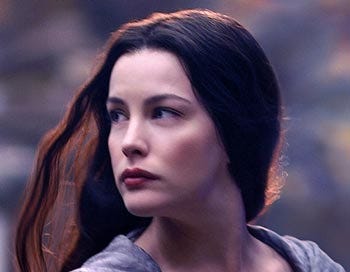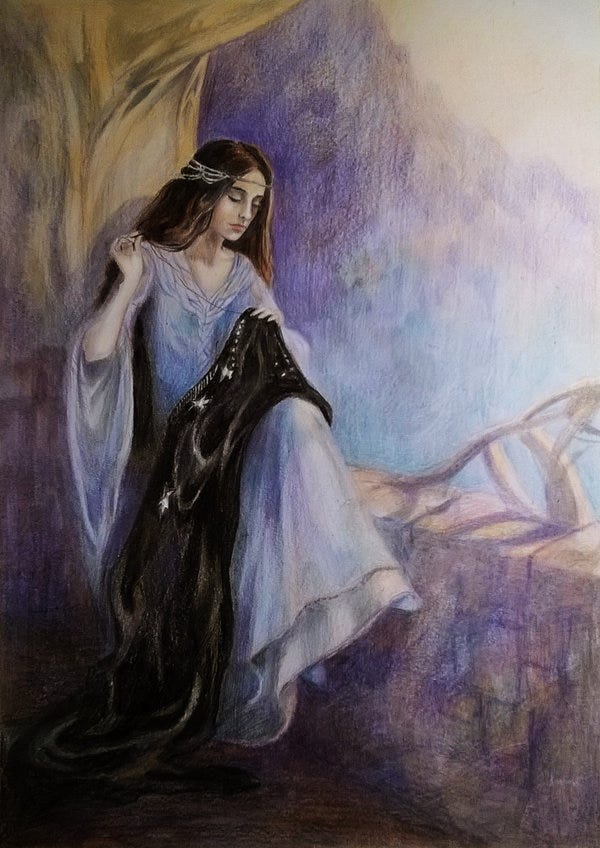There are only a few other female characters that Tolkien devotes several excerpts of text to in The Fellowship of the Ring; one of these is Arwen, the daughter of Elrond and Lady of Rivendell. Next to Goldberry, she is my favorite character in the series in part because of how much I adore Liv Tyler, which I think has nothing to do with Tolkien, but anyways…Today, I am discussing her introduction in The Fellowship of the Ring and its connection to Tolkien’s characterization of female figures in LOTR.
Arwen enters the text when Frodo wakes in the House of the Elves. Frodo depicts her appearance by stating;
In the middle of the table, against the woven cloths upon the wall, there was a chair under a canopy, and there sat a lady fair to look upon, and so like was she in form of womanhood to Elrond that Frodo guessed that she was one of his close kindred. Young she was and not so. The braids of her dark hair were touched by no frost; her white arms and clear face were flawless and smooth, and the light of stars was in her bright eyes, grey as a cloudless night; yet queenly she looked, and thought and knowledge were in her glance, as one of who has known many things that the years bring. Above her brow her head was covered with a cap of silver lace netted with small gems, glittering white; but her soft grey raiment had no ornament save a girdle of leaves wrought in silver (Tolkien 221).
This initial description of Arwen painted by Tolkien is one of beauty and virtue. In this description, Tolkien paints her as a woman of age, but the brightness and clarity of her features makes her look much more younger and suggests an inward purity. Her beauty is the focal point of the scene with Frodo being transfixed on her features. It also to make note that where she is introduced in the text is within the home, against a tapestry.
Tolkien continues to depict the scene where Frodo discovers Arwen by stating, “So it was that Frodo saw her whom few mortals had yet seen; Arwen, daughter of Elrond, in whom it was said that the likeness of Luthien had come on earth again; and she was called Undomiel, for she was the Evenstar of people” (Tolkien 221). This detail is important when one considers the character, Luthien. Luthien was an Elven maiden and considered to be the most beautiful. This detail shows that her beauty surpasses normal expectations. Despite her immortality as an Elf, Luthien falls for a mortal, Beren. Luthien ultimately chooses mortality to remain with Beren. The history of Beren and Luthien makes Tolkien’s comparison of Arwen to Luthien suggestive. This comparison foreshadows that she will end up with Aragon (spoiler!) and suggests that she is kindhearted and morally upstanding like Luthien.
These initial descriptions and the comparison to Luthien craft a larger argument concerning Tolkien’s depiction of women: that these characters are representative of medieval womanhood. Characters, like Arwen and Goldberry first appear in domestic spaces. Although most of the scenes in Lord of the Rings take place outside, Tolkien introduces or has his male characters interact with female characters in the home. Frodo first spots Arwen in the dining room behind a tapestry (one that likely would have been constructed by her or a fellow woman). Goldberry interacts with the hobbits as she feeds them dinner and prepares them a place to sleep. Additionally, Galadriel meets them in her home following the hobbits’ escape from Moria. All of these women are to remain and interact in their space of the home.
Tolkien continues to point to the connections of his female characters and medieval womanhood with how these female characters interact in battle or adventure. Rather than directly participating, they give their male companions aids to help them continue to adventure or fight. An example of this is Galadriel giving the hobbits cloaks or Goldberry providing them with ample food and bedding. Arwen’s case is unique because she interacts in battle in a way different from Galadriel and Goldberry: her relationship with Aragorn conveys a medieval romance, one of chivalry and courtesy where he fights for his maiden.
While Arwen is an interesting character, it is a shame that we don’t see much from her or other female characters outside of their ability to relate to medieval womanhood. While all of these women are virtuous and good, they are not very interesting because they do not get to directly interact in these spaces like male characters do. As I continue to read, I am going to further look at the connections between female characters and medieval womanhood because I think this connection explains why people criticize Tolkien’s lack of and portrayal of female characters throughout LOTR.
My latte (iced, lavender, with oatmilk) is finished, and I’ll be back next week to discuss ladies and LOTR!







I am especially glad during our Tolkien exploration that you are focusing on the female characters. I think what you said about them being "aids" to the male experience–that is adventure and battle–is very apt. We do see Goldberry helping Tom Bombadil "host" the hobbits; she is seen in scenes where she either feeds them, tucks them for a good night of rest, or brings peace to their minds about the future. Arwen, like Goldberry, is described largely through her beauty, and she is thus connected to other women (Luthien) through physical appearance. In the context of action, we rarely see them outside of the home or outside of a narrative related to men. I think, however, that Galadriel–in comparison–is much more autonomous and important in her own right and less by her relations. I think the Lady of Rohan, Éowyn, will be an interesting comparison for both when you eventually get to her.
This is a great post. One thing that I noticed when reading about Arwen, as well as Goldberry, is how Frodo seems to get struck by their appearance. I have noticed that Tolkien have been introducing some interesting female characters. Although we don't see them as much it is nice to at least have them and get a little bit of their background.